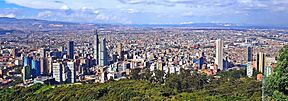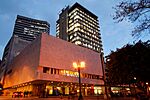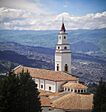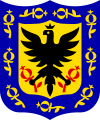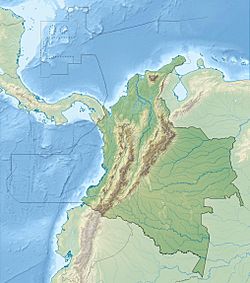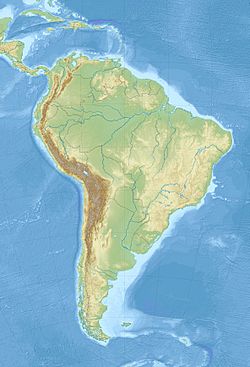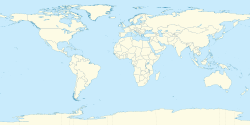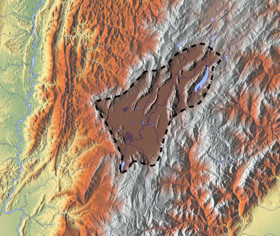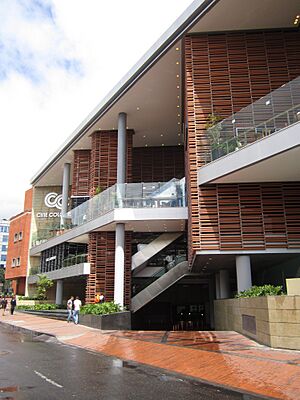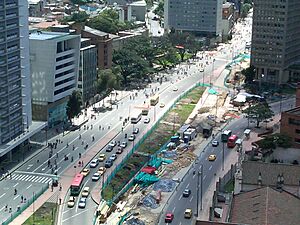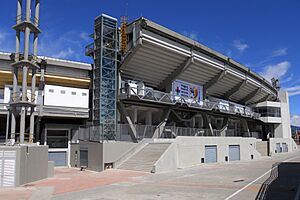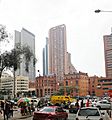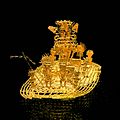Bogotá facts for kids
Quick facts for kids
Bogotá
|
|||||
|---|---|---|---|---|---|
| Bogotá, Distrito Capital | |||||
|
Skyline of the International District of Bogotá with the tallest buildings in Colombia
National Museum
Monserrate Sanctuary
National Park
Bolívar Square, with Palace of Justice (left), Primatial Cathedral (center) and National Capitol (right)
|
|||||
|
|||||
| Nicknames:
"La Atenas Suramericana"
("The South American Athens") "La Ciudad de Todos" "La Capital Mundial del Teatro" ("The Noblest and Most Loyal City") |
|||||
| Motto(s):
"Bogotá Reverdece"
("Bogotá Green", 2020–2023) |
|||||
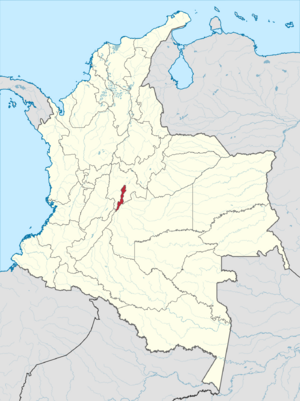
Bogotá, Distrito Capital shown in red
|
|||||
| Country | Colombia | ||||
| Department | Capital District Cundinamarca (see text) |
||||
| Founded | 1538
|
||||
| Founded by | Gonzalo Jiménez de Quesada | ||||
| Area | |||||
| • Capital city | 307.36 km2 (118.67 sq mi) | ||||
| • Urban | 1,587 km2 (613 sq mi) | ||||
| Area rank | 32nd | ||||
| Elevation | 2,640 m (8,660 ft) | ||||
| Population
(2022)
|
|||||
| • Capital city | 8,034,649 | ||||
| • Rank | 3rd in South America 1st in Colombia |
||||
| • Density | 25,000/km2 (65,000/sq mi) | ||||
| • Urban | 7,968,095 | ||||
| • Metro | 11,658,211 | ||||
| Demonym(s) | Bogotan bogotano, -na, rolo (informal), cachaco (informal) (es) |
||||
| GDP (PPP, constant 2015 values) | |||||
| • Year | 2023 | ||||
| • Total | $252.8 billion | ||||
| • Per capita | $21,800 | ||||
| Time zone | UTC−5 | ||||
| Postal code |
11XXXX
|
||||
| Area code(s) | +57 601 | ||||
| HDI (2019) | 0.813 very high · 1st of 33 |
||||
| Largest locality by area | Sumapaz – 781 square miles (2,020 km2) | ||||
| Largest locality by population | Suba (1.218.213 – 2015 est) | ||||
| Largest locality by GDP | Chapinero – US$54 billion | ||||
| Primary Airport | El Dorado International Airport BOG (Major/International) |
||||
| Secondary Airport | CATAM none (Military) Guaymaral Airport none (Private Activities) |
||||
| Bus rapid transit | TransMilenio | ||||
| Bike Paths | R2-R29 | ||||
| Rapid Transit | Bogotá Metro (first line expected to start service in 2028) | ||||
| Tramway | Trams in Bogotá Teleférico de Monserrate |
||||
Bogotá is the capital and largest city of Colombia. It is also one of the biggest cities in the world! Bogotá is located in the center of Colombia, high up in the Andes mountains. It's known as the "Capital District" and is a very important center for politics, economy, culture, and education in Colombia and northern South America.
The city sits on a high plateau called the Bogotá savanna, which is about 2,640 meters (8,660 feet) above sea level. This makes Bogotá one of the highest major cities in the world. It has a cool climate all year round.
Bogotá is home to the main offices of the Colombian government, including the President, Congress, and Supreme Court. It's a major hub for business and finance in Colombia and Latin America. The city's main airport, El Dorado International Airport, is one of the busiest in Latin America. Bogotá also has many universities, research centers, theaters, libraries, and museums, making it a lively cultural spot.
Contents
What's in a Name?
The name Bogotá comes from the Spanish way of saying Bacatá (or Muyquytá). This was the name of a nearby settlement where the Muisca people lived. Some people think Muyquytá means "walling of the farmland" in the Muisca language. Others believe it means "The Lady of the Andes" or was the name of a Muisca leader.
When the Spanish founded the city, they first called it "Our Lady of Hope." Later, in 1540, the Spanish crown changed the name to Santafé (Holy Faith). After Colombia became independent, Simón Bolívar changed the name back to Bogotá to honor the Muisca people.
A Look Back in Time
Early Days
Long, long ago, the area where Bogotá is now was home to hunter-gatherers. The oldest signs of people here are from about 12,500 years ago! Later, the Muisca people settled in the valleys and highlands. They were an advanced civilization known for their farming, salt production, and gold work. They had a complex calendar and believed in many gods related to nature.
Spanish Arrival
In 1538, a Spanish explorer named Gonzalo Jiménez de Quesada led an expedition into the Andes. He and his soldiers met the Muisca people. On August 6, 1538, Quesada founded a settlement, which he called Nuestra Señora de la Esperanza (Our Lady of Hope). This is usually considered the founding date of Bogotá.
The city officially became "Santa Fe" in 1540 and grew to be an important center for the Spanish in the region. It became the capital of the "New Kingdom of Granada."
Becoming Independent
In the late 1700s and early 1800s, people in the Spanish colonies started wanting independence. A man named Antonio Nariño helped spread ideas about human rights and freedom. This led to a movement for independence.
On July 20, 1810, the people of Santa Fe declared their independence from Spain. After some years of fighting, Simón Bolívar led his army to victory in 1819. He arrived in Santa Fe on August 10, 1819, and renamed the city Bogotá. It then became the capital of the new nation of Gran Colombia, and later, the capital of the Republic of Colombia.
Modern Bogotá
Throughout the 19th and 20th centuries, Bogotá grew a lot. People from rural areas moved to the city, making it bigger and more diverse. The city saw many changes, including new buildings, industries, and public services.
In the 21st century, Bogotá has continued to grow and modernize. It has improved its public transport system, like the TransMilenio buses, and built many new public libraries. The city is working to become a major international business hub in Latin America.
Where is Bogotá?
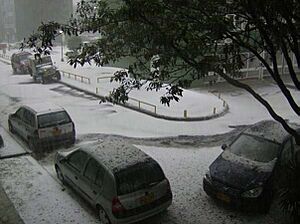
Bogotá is located on a high plateau in the Andes mountains, about 2,640 meters (8,660 feet) above sea level. This plateau is called the Bogotá savanna. To the east, the city is bordered by the Eastern Cordillera mountain range, with mountains like Guadalupe and Monserrate. The Bogotá River forms the western border.
The city has a cool climate all year round. The average temperature is about 14.5°C (58°F). It has dry and rainy seasons. The driest months are December, January, July, and August. The rainiest months are April, May, September, October, and November. Even on sunny days, the temperature usually stays mild.
How Bogotá is Organized
Bogotá is divided into 20 areas called "localities" or districts. Each locality has many neighborhoods. The wealthier areas are usually in the north, closer to the Eastern Hills, in districts like Chapinero and Usaquén. Middle-class areas are in the central, western, and northwestern parts. Working-class neighborhoods are mostly in the south.
The city's streets are set up like a grid. Calles (streets) run from west to east, and their numbers go up as you go north or south from Calle 0. Carreras (roads) run from north to south, and their numbers go up as you go west from Carrera 0. This makes it easy to find your way around!
People of Bogotá
Bogotá is the biggest city in Colombia, with over 7.4 million people living within the city limits (as of 2018). Most of the people in Bogotá are of mixed European and Indigenous heritage (Mestizo) or White. There are also smaller groups of Afro-Colombian and Indigenous people.
Many people have moved to Bogotá from other parts of Colombia over the years, often for better jobs or to escape difficult situations in their home regions. This has made Bogotá a very diverse city with people from all over the country.
Bogotá's Economy
Bogotá is the main economic and industrial center of Colombia. It's a very attractive city for global companies and is a top destination for new foreign investments in Latin America. The city has the highest GDP (a measure of economic activity) in Colombia, making up almost a quarter of the country's total.
Tourism in Bogotá
Tourism is an important part of Bogotá's economy. The city is a growing place for international meetings and events. For example, the World Summit of Nobel Peace Laureates was held here in 2017.
There are many interesting places to visit in Bogotá:
- The historic area of La Candelaria has old hotels, museums like the Botero Museum and the Gold Museum, and a lively atmosphere.
- You can take a cable car or funicular up to Monserrate Sanctuary for amazing views of the city.
- The Bogotá Botanical Garden is a beautiful place to see plants.
- Other popular spots include the planetarium, Maloka (an interactive science museum), and the Quinta de Bolívar (Simón Bolívar's former home).
- Bogotá also has many green parks and amusement parks like Salitre Magico and Mundo Aventura.
- For food lovers, areas like the G Zone, T Zone, and La Macarena offer many fine restaurants.
Shopping Malls
Bogotá has many modern shopping malls. Some of the well-known ones include Centro Andino, Centro Mayor, Santafé, and Gran Estación. These malls offer a wide variety of stores, restaurants, and entertainment options.
Getting Around Bogotá
Bogotá has a large public transport system. The main system is TransMilenio, which uses special articulated buses that run on dedicated lanes. Smaller "feeder" buses bring passengers from neighborhoods to the main TransMilenio stations. The city is also working on building its first metro (subway) lines, with the first line expected to open in 2028.
Bogotá is also famous for its extensive network of bicycle paths, called ciclorrutas. It's one of the largest bike path networks in the world! On Sundays and public holidays, many main roads are closed to cars for "Ciclovía," allowing people to bike, walk, and exercise freely.
The main airport is El Dorado International Airport, located west of the city. It's a major hub for flights within Colombia and to other countries.
Learning in Bogotá
Bogotá is sometimes called the "Athens of South America" because it has so many schools and universities. There are many public and private universities, including the large National University of Colombia. The city is a great place for students to learn and grow.
Culture and Fun
Bogotá is a vibrant cultural center with many museums, art galleries, libraries, and theaters.
- The Luis Ángel Arango Library is one of the most important libraries in the region, attracting millions of visitors each year.
- The Colombian National Museum is one of the oldest museums in the Americas.
- The Gold Museum has the largest collection of pre-Columbian gold in the world.
- The Botero Museum features works by famous Colombian artist Fernando Botero and other international artists.
Bogotá hosts the Ibero-American Theater Festival, which is one of the largest theater festivals in the world. The city also has many music festivals, like "Rock al Parque," where thousands of people enjoy free concerts.
Food in Bogotá
When you're in Bogotá, you should try some traditional dishes!
- Ajiaco is a delicious soup made with chicken, different kinds of potatoes, corn, and a special herb called guascas. It's often served with sour cream and capers.
- Tamales are another popular dish, made with a mix of rice, meat (like beef or pork), chickpeas, and spices, all wrapped in plantain leaves and steamed.
For desserts, try figs with arequipe (a sweet caramel sauce) or strawberries with cream. And to drink, Canelazo is a warm, sweet drink made with a type of sugar cane juice, cinnamon, and sometimes a bit of a local alcoholic drink called aguardiente.
Sports in Bogotá
Football (soccer) is very popular in Bogotá. The city has three professional football clubs: Santa Fe, Millonarios, and La Equidad. Their main stadium is The Campín Stadium (Estadio Nemesio Camacho El Campín). Bogotá also has other sports venues for swimming, cycling, and more.
City Symbols
- Flag: The flag of Bogotá has two horizontal stripes: yellow on top and red on the bottom. Yellow represents the gold from the earth and good qualities like justice and joy. Red stands for charity, bravery, and honor.
- Coat of Arms: The city's coat of arms was given by a Spanish king in 1548. It shows a black eagle, which means strength, holding a red pomegranate. The border has olive branches and nine golden pomegranates, representing the nine original areas of the New Kingdom of Granada.
- Anthem: Bogotá has its own official song, or anthem, with lyrics by Pedro Medina Avendaño and music by Roberto Pineda Duque.
Images for kids
-
Bogotá is the second largest city within city limits in South America by population, after São Paulo.
-
Luis Carlos Sarmiento Building of Science and Technology at the National University of Colombia
-
Teatro de Cristóbal Colón (Christopher Columbus Theater)
-
Victorian architecture in Teusaquillo
-
Ajiaco is one of the city's most representative dishes.
-
"Chocolate santafereño" (Santafe hot chocolate), almojábana, cheese and pandequeso
See also
 In Spanish: Bogotá para niños
In Spanish: Bogotá para niños


